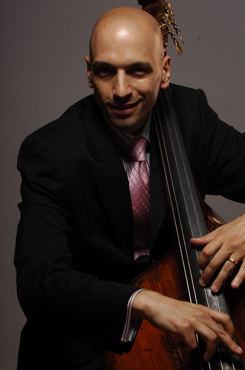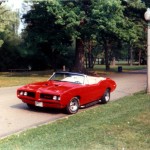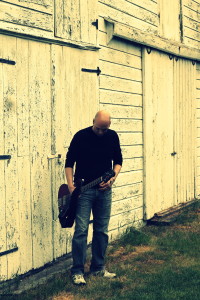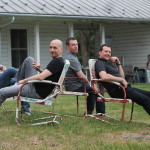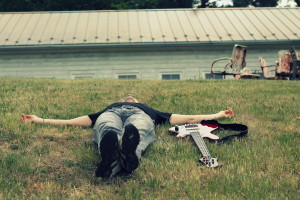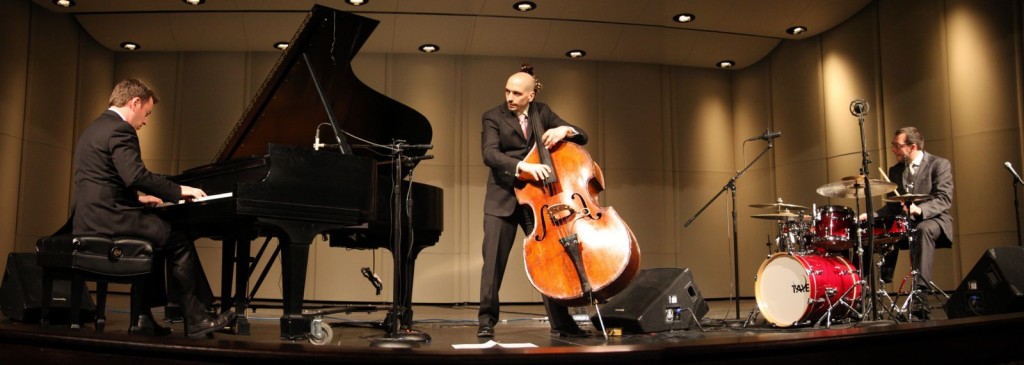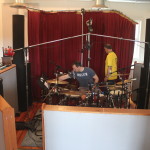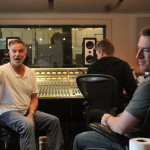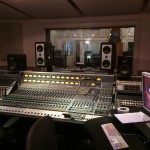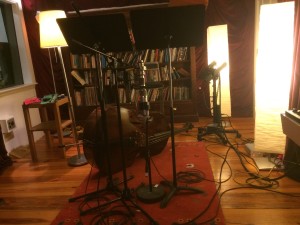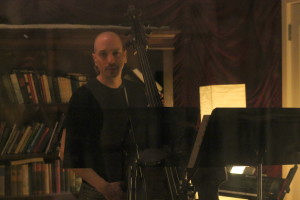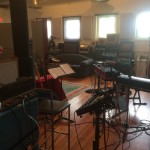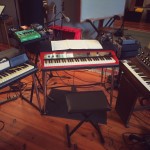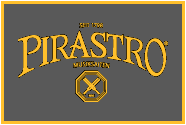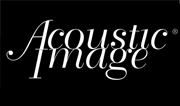Detroit Lean
A New Release by Bassist Phil Palombi!
Order, Download, Digital Liner Notes, Press Release and More!
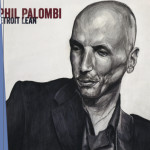 “With my previous recordings, actually with most of my writing, I was always trying to write music that fit into a specific style or band,” says Palombi. “With Detroit Lean, I just wrote music stream-of-consciousness style— whatever popped into my mind. As a result, I think that I unconsciously channeled a wide range of influences and sounds that have been bouncing around in my head over my musical life. I didn’t really care what anyone wanted to hear or about trying to fit a genre. I wanted to see what was inside of me.”
“With my previous recordings, actually with most of my writing, I was always trying to write music that fit into a specific style or band,” says Palombi. “With Detroit Lean, I just wrote music stream-of-consciousness style— whatever popped into my mind. As a result, I think that I unconsciously channeled a wide range of influences and sounds that have been bouncing around in my head over my musical life. I didn’t really care what anyone wanted to hear or about trying to fit a genre. I wanted to see what was inside of me.”
– Phil Palombi, April 2016
“Palombi is an extraordinarily brilliant bassist who is in his element on acoustic or electric bass. In all this is a magnificent release from a bassist deserving of much wider recognition.”
– Raul da Gama, June 2016, Jazz da Gama
– Rochester City Newspaper, April 2016
– Chris Spector, April 2016, Midwest Record
Purchase CDs or Vinyl!
Physical Physical CD – $12.95 (Free Domestic Shipping!)
Purchase an actual CD, if you still happen to own a CD player 😉 You can read the full liner notes here on the website!
Limited Edition Vinyl (comes with a CD quality download!)
Limited to only 300 copies, audiophile 180gram pressing, cut by the great Scott Hull at Masterdisk and pressed at Gotta Groove. No expense has been spared in this pressing! Domestic shipping and packaging is $7. If you live overseas, please select the internatiol shipping option upon check out ($17 total for international orders).
Purchase Downloads
(Please make sure NOT to enter your zipcode in the shipping calculator in PayPal)
MP3 Download – $9.99
HD Audio – 96k-24bit Download – $15.95
Sound Samples
Beyond the Wall(Palombi)
Detroit Lean (Palombi)
The Phoenix (Palombi)
Push-Pull (Palombi)
I’ll Never Go Back to Brooklyn (Palombi)
Stay the Same (Cion)
Alternate Side Parking (Palombi)
Standing Through Time (Palombi)
Sarah’s Theme (Palombi)
Take Both Paths (Palombi)
Digital Liner Notes
Detroit Lean. If you didn’t grow up in the rust belt, then you probably have no idea what that term means. The short answer. It’s trying to look cool while sitting behind the steering wheel of a car. There are two ways to “Detroit Lean.” Back when big American cars had giant bench seats, you would slide over to the middle, lean even further to the right, and maybe put your arm around your girlfriend while you were over there. When bucket seats took over, you would recline your seat way back and slouch.
I always loved the sound of that phrase. Coming from Youngstown, Ohio, where a major employer in the area was General Motors, the city of Detroit was kind of a Emerald City. It was the heart of American manufacturing. The rust belt was a car culture, and my earliest childhood memories revolve around various machines- mom’s ’62 Ford Fairlane, grandma’s ’70 Camero, grandpa’s Cadillacs, uncle Joe’s 72 Bonneville convertible, and of course my fathers looooong history of cars- the ’66 427 Corvette, Roadrunners, Cameros, the Merc’, ’27 Ford… holy cow did he have a lot of cars! It was a family tradition. For my first car my parents saved a 1968 GTO convertible from a future in the scrap yard. The catch? I had to rebuild it and get it road ready before my 16th birthday. His reasoning was that if I put my blood, sweat, and tears into the machine, I would respect it. He was right. Back then cars were more than transportation, they were family members, and Detroit was the maternity ward.
Now I live in the Bronx, having long ago sold my GTO to buy an acoustic bass. My gear-head days are behind me. However, the mystic of Detroit is still rooted in the base of my brain stem. I’ve been visiting Detroit often over the last handful of years to perform and I have to say that I LOVE that town. It’s amazing to see the transition that it’s going through right now. A true renaissance- mom and pop stores everywhere, lots of artists and clubs, and amazing architecture. You can still imagine John DeLorean screaming through town in his modified 389 Tempest, bumper to bumper with the hot Ford of the day. Don’t even get me started on the long list of musicians that are attached to Detroit’s history! The city still has a vibe. It’s with that in mind that I decided to name my record Detroit Lean.
About the Music
With my previous recordings- actually, with most of my writing, I was always trying to write music that fit into a specific style or band. With this CD, I just wrote music “stream of conscious” style. I wrote whatever popped into my mind. As a result, I think that I unconsciously channeled a wide range of influences and sounds that have been bouncing around in my head over my musical life. I’ve played quite a bit of music in my career so far. I started out playing rock, blues, soul, country, then I dove head first into jazz, studied classical (playing in a symphony orchestra for about five years), all before I moved to NYC. Once here, I joined salsa bands, Brazilian pop bands, spoken word, free jazz. You name it, I’ve probably played it! When I sat down at the piano to write, I would close my eyes and try to hear what was going on in my head in that moment. Sometimes I would hear a rhythm, other times I would hear a track from a recording that I loved. I wouldn’t over think it, I would just write- get it out of my head.
Inspiration. For some reason I can’t just sit down and write a song for the sake of writing a song. I don’t know why, but I need to have a real relationship with what’s going down. Sometimes I can look into the future and pull something from there, but most of the time it’s looking back and analyzing my feelings about an event or person. Last year I was doing just that. I was marveling at the set of circumstances and decisions that lead me to where I am now. It really is a bit miraculous, actually. I grew up in the country outside of Youngstown to a family of a long line of factory workers, yet somehow I managed to eject, move to NYC with nothing to my name, and travel the world. When you look back, you can see maybe a handful of decisions where, had you simply changed one thing, your life could have been completely different. I think it would be fun to be able to go back in time, choose another path, than move forward to see what would happen. Okay, so maybe I read entirely too much Sci-Fi. Still, it helps me remember why I am where I am now, and what I need to do to stay on the path that I’ve chosen. It’s not that I get whimsical about the past. It’s more about using the past as a kind of mental straight edge to keep me moving in the right direction.
The Songs
Beyond the Wall: The title is a Game of Thrones reference. In the books, the wall symbolizes a physical and personal separation. The wall in the story got me to thinking about our own personal walls that we put up around us and how much we can accomplish if we get past them. People get their own ideas about what’s beyond the wall that, most of the time, have nothing to do with reality.
Detroit Lean: This song is a complete “turn it up and drive into the sunset” kind of song. Sometimes we would go for a drive with no destination in mind. Going for a drive just for the sake of going for a drive. The sound of the bass on the melody is not an effect pedal. I was trying to decide if I wanted the melody up the octave or down an octave, so I did it both ways. When we were listening to the playback, the engineer George Petit accidentally played both tracks at the same time. Everyone lit up! Yep, keep both! Just for the fun of it, I overdubbed one lick of my solo down an octave. You’ll hear it…
The Phoenix: This wasn’t going to be the title originally. Back when I was a teenager, my parents used to hang out at a club called the Phoenix that had live music on the weekends. My mom loved to dance, and my dad (who used to play guitar part time) would hang out and check out the music. They were down there nearly every weekend, and when I was around 15, I started sitting in with the band whenever I could. It was a cover band that played all the pop dance hits of the time. My mother passed away suddenly last fall while I was in the middle of mastering this record. I was sifting though photos trying to find a few nice ones to print out for the funeral home when I came across a video from a year ago of my parents dancing together at my God daughter’s wedding. All of a sudden a ton of memories came flooding back to me of seeing my parents dancing and partying at the Phoenix. It seemed like the perfect fit- a happy dance tune dedicated to my mom.
Push-Pull: This is a love song. The term comes from tube amplifiers. I am a total stereo dork, by the way… Anyway, the definition is “having or involving two matched tubes or transistors that operate 180 degrees out of phase, conducting alternately for increased output.” Man, if that’s not the definition of marriage, I don’t know what is! People seem to think that a perfect relationship is two people that are in constant agreement. To me it seems that being polar opposites has more of an advantage from an evolutionary standpoint.
I’ll Never Go Back to Brooklyn: This was my first choice as a title for the CD, but John Patitucci beat me to it with his DVD documentary Back in Brooklyn! I didn’t want to come across as snarky. The amazing thing about this song is it’s only one take. Actually, it was the first time we even played the tune. We were hanging in the studio around 1am after a long day, drinking a few beers, and I mentioned that we should just run the tune down as a rehearsal and we’ll track it in the morning. George hit record because, well, why not, right? That was it. It had a vibe. I kicked everyone out of the room and I tracked the melody and bass solo over top of it in one take. Done. At the end of the week we added a few overdubs, notably a 2nd solo bass line that just echoes the primary bass in spots. The song title seems to draw a lot of fire from people who think that it’s an insult leveled at Brooklyn. Nothing could be farther from the truth! When I moved to NYC, I landed in Brooklyn. I loved being there. After about four years of living there, I got married and moved to the Bronx and my life changed forever. It’s not that I don’t want to go back to Brooklyn, it’s that I’ll never be able to go back to that time when I lived in Brooklyn. That said, when I have to drive to Brooklyn from the Bronx and deal with insane traffic to get there, I do sometimes say to myself that I’ll never go back to Brooklyn!
Stay the Same: This song was written by my wife, Sarah Jane Cion (who’s a great jazz pianist) back around the time that I moved to Brooklyn before we started dating. Every one of my CDs has featured a song by her, and this is one of my favorite compositions by her. She even wrote lyrics for it, though I chose not to sing for what would be obvious reasons (if you ever heard me sing). It appears on Sarah’s first CD as a leader with Carolyn Leonhart singing. I wanted to bow a melody to something on this record, but I didn’t feel like playing or arranging a standard, and nothing I was writing made sense to bow. Given that set of conditions, plus the fact that this was always one of my favorite compositions by Sarah, made it obvious to me.
Alternate Side Parking: This song references the ritualistic evening hunt for a parking spot coming home from a gig at 3am. The Amazon rainforest tribal effects were the idea of the mixing engineer George Petit. I think it perfectly captures the attitude that I feel when trying to find a parking spot in NYC!
Standing Through Time: I am a science nerd. Every once in a while I’ll read an article about the nature of time and the universe that will capture my imagination. Once such article was about how there is no flow of time, only a collection of “nows.” The flow of time is just an illusion.
Sarah’s Theme: I originally wrote this as a piano trio waltz for my wife, who I have affectionately nicknamed “Chick Evans” due to her piano style. However, in the studio, the tune swung in a completely different direction.
Take Both Paths: The title was inspired by the famous Robert Frost poem The Road Not Taken. When I combine my inner science nerd with my nostalgic side, I sometimes wonder how cool it would be to pop back in time and try a completely different direction without giving up my current path. You know, your basic many-worlds interpretation of quantum mechanics.
About the Band
The core trio, Matthew Fries on piano and Keith Hall on drums, goes way back with me. I met Keith first shortly after I moved to NYC. I knew a lot of his college friends from Michigan, so when I met Keith there was already a bit of history in place. We locked in the first time we played together and that was it- we kind of became a rhythm section team that people would call together. I met Matthew at a gig shortly after. It was just some club date money gig type of thing, but we had a lot of fun playing together.
At one point around 2002, both Keith and Matthew were backing a vocalist. The bass chair opened up and both of them, without talking to each other about it, recommended me. We ended up becoming the backing trio for this guy for five years, playing about 110 gigs a year on the road. Things got to be really tight, so we decided to use the opportunity to start making records under our own name- Tri-Fi. We’ve release six records as Tri-Fi after over 11 years of playing together!
Anyway, when it came time for me to pick a band to play my original music, it was a no-brainer. These guys instinctively know exactly what I want to hear after all these years. We are a real band. What makes my project different than a Tri-Fi album, though, is that I had total control over the style and sonics of the project (not to mention all of the compositions, of course). Tri-Fi is an acoustic piano trio. It’s a modern style, but you’ll never hear and electric bass or Fender Rhodes on a Tri-Fi record. Of course, even though I had complete control, I was still counting on Matthew and Keith to make contributions and suggestions.
Guitarist Tony Romano is my neighbor up here in the Bronx. I’ve known T-Rom (as I’ve dubbed him) for years, though I can’t remember how we met. Originally I wanted Tony to simply lay down a bunch of Brazilian and flamenco guitar parts, which he excels at, but as the project got under way I ended up having him track all sorts of stuff, including a handful of great solos.
The fifth Beatle in the band is the recording and mixing engineer George Petit. I’ve know George for about 10 years now. When I made the mental decision to make this record, back before I even started writing music, George was the first person that I spoke to. I trust his engineering skills, but that’s not why he got the gig. I wanted two things from him- 1) To experiment with sounds and overdubs in the studio, and 2) I wanted him to add post-production effects to the record when he was mixing. I asked him to, in essence, become a
member of the band from the mixing console. I had some specific ideas of what I wanted in a few places. I would say something like “give me something swirly and weird at the end of this track” and leave it up to him to figure out what I meant and what works. However, I also wanted him to completely take the initiative and come up with ideas on his own. For example, the soccer game sounds on The Phoenix and the Amazon tribe on Alternate Side Parking were a complete surprise! George is a guitarist and composer as well, so I felt comfortable giving him the freedom to experiment.
About the Studio
It was very important for me to pick the right studio. I relied on Petit to advise me where to go, and he picked one of the best studios in the world- the Clubhouse in Rhinebeck, NY. Recording your own project can be nerve wrecking to say the least, so it’s important to pick a studio that won’t add to your mental load. The Clubhouse had everything I needed to allow me to focus on music: an amazing space with a large “live room,” an amazing vintage Neve console, a great microphone selection, every piece of gear you can think of (Wurlitzer, Moog, Rhodes, grand piano, amps, drums, you name it), and best of all, a living space. We moved into a converted barn on Tuesday night and lived 10 feet from the control room until Sunday morning. Now THAT’s the way to make a record. It’s amazing how much more relaxed and focused you feel when you can roll out of bed and stagger into the studio at any time day or night.
In addition to focusing on the music, I really wanted to focus on the sound quality. It’s hard for me to be unbiased, but I believe that I’ve captured something that sounds as good as anything coming out of a major label these days. The CDs sound great, but you should hear the tracks in the 96k-24bit High Definition Audio format. Even better yet, buy a limited edition vinyl copy that was mastered by the legendary Scott Hull! George spent a lot of time placing microphones in optimal positions, then even more time mixing the tracks at his home studio. I couldn’t be happier with the results!
Okay, I Know That You REALLY Want to Talk Gear
My childhood car obsessions have reemerged as a fondness for gear and basses. Here’s what I was using!
For the acoustic bass, I once again had Scott LaFaro’s amazing 1825 Prescott bass. Yes, it is the bass that he used on the Bill Evan’s Vanguard sessions! This time around, however, I had the bass for six months and I was allowed to take it anywhere. I took it everywhere! Most notably, I brought the bass back to the Village Vanguard for the first time since LaFaro played it there in 1961. George put a Brauner VMA and a Neumann FET 47 large diaphragm condensers in front of it and that was it.
I brought a bunch of electric basses to the studio, but ended up using two. My four string Fleet (now called L.H. McCurdy Basses) and a Carey Nordstrand 6 string. The Fleet is all over I’ll Never Go Back to Brooklyn, and it’s also the rhythm track on Take Both Paths. I needed a little more range for the solo on Take Both Paths, so I enlisted my Nordstrand 6.
My secret weapon was the D.I. I used my completely rebuilt 1961 Ampeg B15n without the speaker cabinet. I attached a dummy load box to the speaker out and a Radial Engineering JDI to the ext amp out, which then simply ran into the vintage Neve console. This allowed me to send the sound of the preamp and power amp tubes of the Ampeg without having to mic a speaker. I love the B-15 speaker cabinet, but that was a little too vintage for this record. I was looking for something a little more modern sounding. The B15n head had everything I needed- clarity, warmth, and punch! There is also a story that Ampeg built this particular Ampeg for Scott LaFaro, but that’s a story for another time…
That’s it for my stuff on this record. For our drummer Keith, he used an assortment of drums that the studio had, and brought his own cymbals and a snare or two. One trick that Petit did was set up and mic three different snare drums for Keith so he could change on the fly. If you listen to Detroit Lean, the snare drum changes when the piano solo starts. That’s not a studio trick- Keith just started hitting snare number two.
For Matt, we had a piano booth for the acoustic tracks, but we also set up an electric keyboard station that had a great house Wurlitzer and his personal Vintage Vibe Electric Tined Instrument (basically a perfect Fender Rhodes), along with his effects board and pedals.
Tony Romano was easier. We just locked him in a tiny closet with about five guitars and kept him there for four days straight. He had a newer Fender Telecaster style guitar, as well as an amazing classical nylon string, Flamenco guitar, and a standard strummin’ singer songwriter acoustic guitar. The Clubhouse has an amplifier isolation closet, so George also took a miked guitar amp track for a few things.









